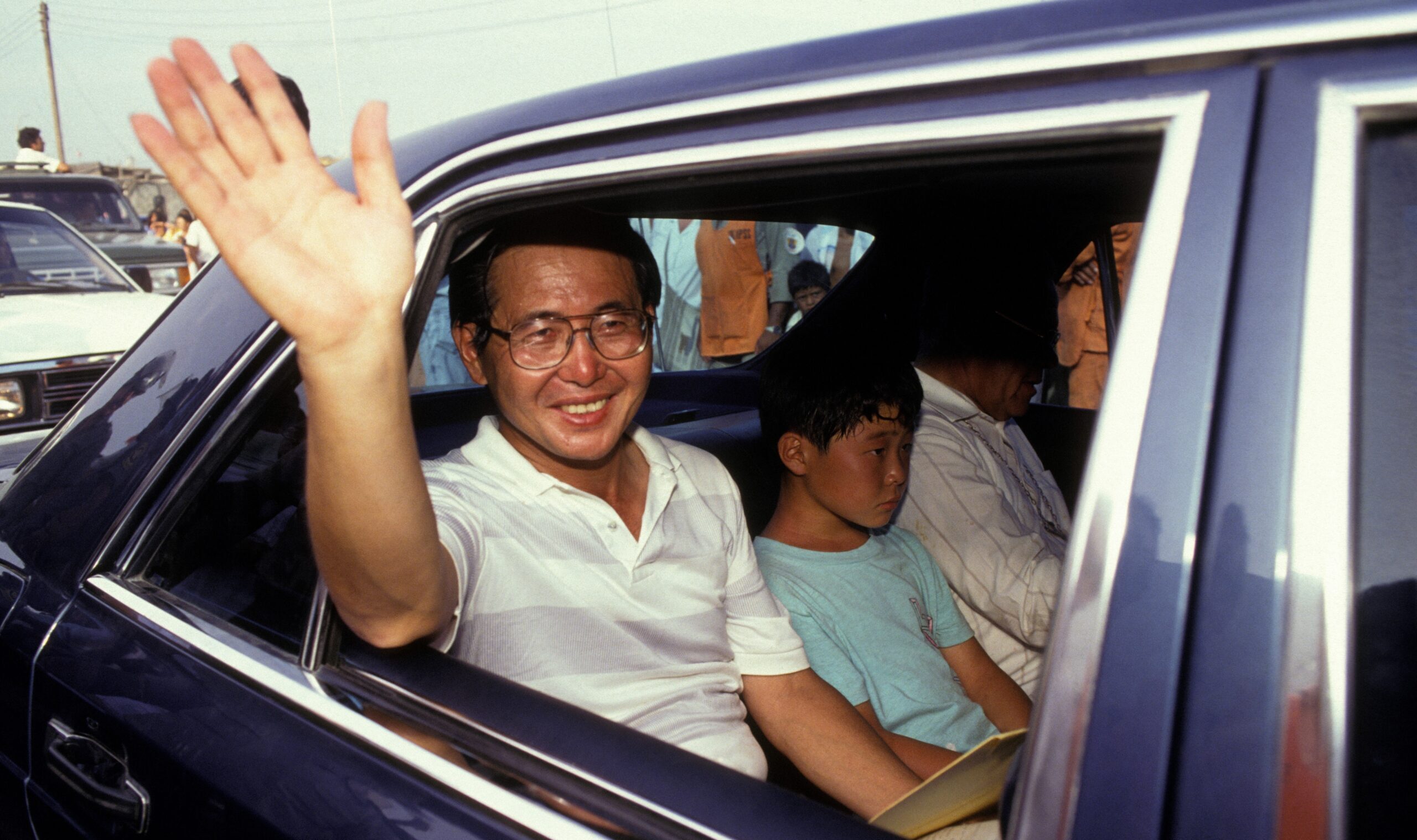Foreign Affairs
The conservative former president’s legacy is defined by massive successes—and equally massive failings.

Alberto Fujimori, the former president of Peru, died of natural causes Wednesday evening in the home of his daughter, the politician Keiko Fujimori. He had only recently been freed from imprisonment in December 2023, where he had been confined since 2007 after being convicted of human rights abuses and corruption.
Born in 1938 to Japanese immigrants in Peru, Fujimori rose from obscure origins to command the heights of power in the South American nation, shocking the country with his completely unanticipated victory in the 1990 presidential election against renowned novelist Mario Vargas Llosa.
A titanic figure in Peruvian politics, Fujimori was widely beloved during his time as president for having pulled Peru back from the brink of economic collapse and for finally shattering the power share of various Marxist guerillas who afflicted the country during previous decades. By 1990, nearly a third of Peru was under the control of the Marxist revolutionary group known as the Shining Path, which dominated much of the rural countryside and threatened the capital of Lima. Brutal even by communist standards, Shining Path militants terrorized uncooperative citizens—men, women, and children alike—conducting dozens of bombings in Peruvian cities and murdering villagers in the countryside by beheading them, hacking them to death with machetes, stoning them, and at times even scalding them to death with hot water.
After a decade of ineffective and harsh efforts conducted by previous governments, Fujimori embarked on a sustained campaign to eradicate the terrorists with the most strenuous and modern methods available. Reorganization of the military and intelligence forces allowed for the capture of the Shining Path’s leader, Abimael Guzmán, in 1992, sharply reducing the group’s cohesion. Sustained cooperation between the military and peasant militias in affected provinces ran the militant group to the ground by the time Fujimori fled the country in 2000. What had been a guerilla war threatening the integrity of the country itself had been reduced to a minor nuisance that has remained easily contained to the present.
The victory came at a heavy cost. The government suspended constitutional rights in affected areas to allow for maximal effectiveness in combating the terrorists, and government forces engaged in massacres of their own, including at Barrios Altos and La Cantuta. The final death toll ran to the tens of thousands, and government forces ultimately killed as many Peruvians as did the communists. Human rights watchdogs were outraged, and Fujimori himself was ultimately convicted for his abuse of military power and carelessness with civilian lives. Nevertheless, his administration did effectively end an ongoing civil war that threatened a far worse outcome for the Peruvian people than occurred, and many were grateful to him for doing so.
As a politician, Fujimori excelled. His rallying cry of “honor, technology, labor” in 1990 gained him the support of the new political classes of small businessmen and evangelical Christians, forming the backbone of the Fujimorist political coalition that continues to be an active force in Peruvian politics to this day.
The Peruvian economy in the year 1990 was collapsing under the dual crises of hyperinflation and declining productivity caused by preceding socialist governments. In response, Fujimori implemented an aggressive reconstruction of the Peruvian economy that came to be known as the fujishock. The rapid privatization of industry, relaxation of currency controls, slashing of tariffs and labor regulations, and elimination of price controls and government subsidies managed to pull Peru out of the economic spiral of the “Lost Decade” of the 80’s and launched a steady period of growth that lasted until the Great Recession, as labor markets tightened and foreign investment poured into the country.
Fujimori’s economic reforms were not without consequences, as unemployment rose with the shuttering of profligate government industry and citizens benefitted unevenly from new outside investments. But the end of hyperinflation and a quickly growing economy after years of decline won Fujimori the confidence of the Peruvian people, and was a major factor in his strong approval ratings throughout his tenure as president.
By 1992, Fujimori had become frustrated with the Peruvian legislature, which was dominated by opposing parties. In response, with the backing of the military and Validimiro Montesinos, his advisor and political partner in the intelligence services, he issued a decree dissolving the legislature and suspending the constitution, allowing him to rule Peru as a dictator and take harsher measures against terrorism. Due to Fujimori’s accomplishments, this action was actually broadly popular among the Peruvian people at the time, and the opposition was able to mount no effective resistance. Fujimori later called for new elections, resulting in a Congress dominated by his supporters, who drafted the Peruvian Constitution of 1993, which continues to function as the fundamental law of the country today.
Continued success allowed Fujimori’s reelection to the presidency by wide margins in 1995, and his popularity would reach its peak in 1996, after Marxist terrorists from the Tupac Amaru Revolutionary Movement stormed the Japanese Embassy and took nearly 400 residents and workers as hostages. After the terrorists had released all but 72 of the hostages and made their demands for the liberation of a number of their guerilla fighters from Peruvian prisons, the Peruvian Armed Forces launched a surprise attack to on the embassy, killing the terrorists and freeing all but 1 of the hostages, who died in the assault. This vivid public accomplishment masked growing discontent with Fujimori’s government, which had become increasingly corrupt over the course of his years in power.
That corruption was ultimately Fujimori’s undoing. The unprecedented flow of foreign investment, the massive influxes of funds from selling off state-owned corporations, the necessity of maintaining his influence in the military, intelligence community, and among investors, and the vices of greed and ambition led inevitably to embezzlement and bribery on a massive scale. Hundreds of millions of dollars, making up a significant portion of government funds, slipped quietly into the hands of friends and supporters. Until, after the election of 2000—which Fujimori won under dubious circumstances—these transfers ceased to be so quiet.
The publication of a video that showed Montesinos, by then chief of the Peruvian intelligence services and Fujimori’s right hand man, slipping a packet thick with bills to an opposition legislator in return for his defection to Fujimori’s political party, turned the country on its head, and his political support cratered. In response, he called for new elections—but, after leaving the country on a state visit to Brunei, he fled to Japan and, infamously, resigned from the presidency via fax.
Subscribe Today
Get daily emails in your inbox
There he remained until 2005, when he declared his decision to run for president in the Peruvian presidential elections the next year. On a visit to Chile, he was arrested, extradited to Peru, and convicted on charges of corruption and human rights abuses, becoming one of the only presidents ever convicted and sentenced in his own country on that account. His declining health occasioned a pardon from President Pablo Kuczynsci in 2017, but his release was delayed by courts until December of last year.
The legacy left by Fujimori, complicated but monumental, will long survive his death. A revived economy, the end of Marxist terrorism, and his own political movement continue to define, in many ways, the politics of the Republic of Peru. His son Kenji and his daughter Keiko are both active in Peruvian politics, heading up a revitalized fujimorist political coalition. Keiko narrowly lost the last three presidential elections, and may run again in the next, while the fujimorist party that she leads is the largest party in the Peruvian legislature.
The sins of the fathers have not yet covered the triumphs of the fathers. Peru may yet choose to build on the better part of Fujimori’s legacy; let us hope it has learned from the worse.

